
In electronics and telecommunications, a radio transmitter or just transmitter is an electronic device which produces radio waves with an antenna. The transmitter itself generates a radio frequency alternating current, which is applied to the antenna. When excited by this alternating current, the antenna radiates radio waves.

Medium wave (MW) is the part of the medium frequency (MF) radio band used mainly for AM radio broadcasting. The spectrum provides about 120 channels with more limited sound quality than FM stations on the FM broadcast band. During the daytime, reception is usually limited to more local stations, though this is dependent on the signal conditions and quality of radio receiver used. Improved signal propagation at night allows the reception of much longer distance signals. This can cause increased interference because on most channels multiple transmitters operate simultaneously worldwide. In addition, amplitude modulation (AM) is often more prone to interference by various electronic devices, especially power supplies and computers. Strong transmitters cover larger areas than on the FM broadcast band but require more energy and longer antennas. Digital modes are possible but have not reached momentum yet.

The Warsaw Radio Mast was a radio mast located near Gąbin, Poland, and the world's tallest structure at 646.38 metres (2,120.7 ft) from 1974 until its collapse on 8 August 1991. Designed by Jan Polak, and one of the last radio masts built under Communist rule, the mast was conceived for height and ability to broadcast the "propaganda of the successes" to remote areas such as Antarctica. It was the third tallest structure ever built, being surpassed as the tallest by the Burj Khalifa tower in the United Arab Emirates in 2009 and Merdeka 118 tower in Malaysia in 2022.

In radio communications, a radio receiver, also known as a receiver, a wireless, or simply a radio, is an electronic device that receives radio waves and converts the information carried by them to a usable form. It is used with an antenna. The antenna intercepts radio waves and converts them to tiny alternating currents which are applied to the receiver, and the receiver extracts the desired information. The receiver uses electronic filters to separate the desired radio frequency signal from all the other signals picked up by the antenna, an electronic amplifier to increase the power of the signal for further processing, and finally recovers the desired information through demodulation.
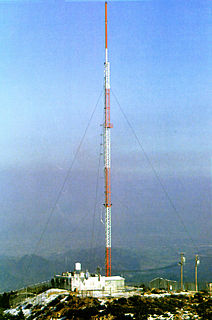
A guyed mast or guyed tower is a tall thin vertical structure that depends on guy lines for stability. The mast itself has the compressive strength to support its own weight, but does not have the shear strength to stand unsupported. It requires guy lines to stay upright and to resist lateral forces such as wind loads. Guy lines are usually spaced at equal angles about the structure's base.
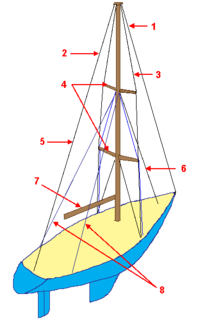
A guy-wire, guy-line, guy-rope, or stay, also called simply a guy, is a tensioned cable designed to add stability to a free-standing structure. They are used commonly for ship masts, radio masts, wind turbines, utility poles, and tents. A thin vertical mast supported by guy wires is called a guyed mast. Structures that support antennas are frequently of a lattice construction and are called "towers". One end of the guy is attached to the structure, and the other is anchored to the ground at some distance from the mast or tower base. The tension in the diagonal guy-wire, combined with the compression and buckling strength of the structure, allows the structure to withstand lateral loads such as wind or the weight of cantilevered structures. They are installed radially, usually at equal angles about the structure, in trios and quads. As the tower leans a bit due to the wind force, the increased guy tension is resolved into a compression force in the tower or mast and a lateral force that resists the wind load. For example, antenna masts are often held up by three guy-wires at 120° angles. Structures with predictable lateral loads, such as electrical utility poles, may require only a single guy-wire to offset the lateral pull of the electrical wires, at a spot where the wires change direction.
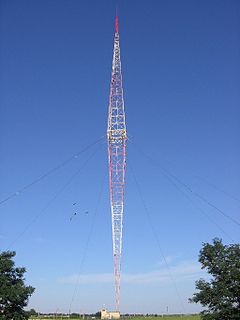
The Lakihegy Tower is a 314-metre-high (1,031 ft) radio mast at Szigetszentmiklós-Lakihegy in Hungary. The Blaw-Knox type tower was built in 1933 and was one of Europe's tallest structures at the time of construction. It was designed to provide broadcast coverage for Hungary with a 120 kW transmitter. It was built for the purpose of transmitting the radio station "Budapest I.", which it served until 1977.
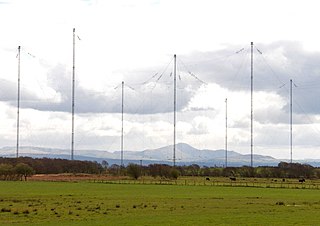
Anthorn Radio Station is a naval and government radio transmitting station located near Anthorn, Cumbria, England, overlooking the Solway Firth, and is operated by Babcock International. It has three transmitters: one VLF; one LF; and an eLORAN transmitter.

The Blaw-Knox company was an American manufacturer of steel structures and construction equipment based in Pittsburgh, Pennsylvania. The company is today best known for its radio towers, most of which were constructed during the 1930s in the United States. Although Blaw-Knox built many kinds of towers, the term Blaw-Knox tower usually refers to the company's unusual "diamond cantilever" design, which is stabilized by guy wires attached only at the vertical center of the mast, where its cross-section is widest. During the 1930s AM radio broadcasting stations adopted single mast radiator antennas, and the Blaw-Knox design was the first type used. A 1942 advertisement claims that 70% of all radio towers in the United States at the time were built by Blaw-Knox.

Radio masts and towers are typically tall structures designed to support antennas for telecommunications and broadcasting, including television. There are two main types: guyed and self-supporting structures. They are among the tallest human-made structures. Masts are often named after the broadcasting organizations that originally built them or currently use them.

A mast radiator is a radio mast or tower in which the metal structure itself is energized and functions as an antenna. This design, first used widely in the 1930s, is commonly used for transmitting antennas operating at low frequencies, in the LF and MF bands, in particular those used for AM radio broadcasting stations. The conductive steel mast is electrically connected to the transmitter. Its base is usually mounted on a nonconductive support to insulate it from the ground. A mast radiator is a form of monopole antenna.
A broadcast transmitter is an electronic device which radiates radio waves modulated with information content intended to be received by the general public. Examples are a radio broadcasting transmitter which transmits audio (sound) to broadcast radio receivers (radios) owned by the public, or a television transmitter, which transmits moving images (video) to television receivers (televisions). The term often includes the antenna which radiates the radio waves, and the building and facilities associated with the transmitter. A broadcasting station consists of a broadcast transmitter along with the production studio which originates the broadcasts. Broadcast transmitters must be licensed by governments, and are restricted to specific frequencies and power levels. Each transmitter is assigned a unique identifier consisting of a string of letters and numbers called a callsign, which must be used in all broadcasts.
A radio transmitter or just transmitter is an electronic device which produces radio waves with an antenna. Radio waves are electromagnetic waves with frequencies between about 30 Hz and 300 GHz. The transmitter itself generates a radio frequency alternating current, which is applied to the antenna. When excited by this alternating current, the antenna radiates radio waves. Transmitters are necessary parts of all systems that use radio: radio and television broadcasting, cell phones, wireless networks, radar, two way radios like walkie talkies, radio navigation systems like GPS, remote entry systems, among numerous other uses.
The Stara Zagora Transmitter was a high power mediumwave broadcasting station near Stara Zagora in Bulgaria.

An umbrella antenna is a capacitively top-loaded wire monopole antenna, consisting in most cases of a mast fed at the ground end, to which a number of radial wires are connected at the top, sloping downwards. They are used as transmitting antennas below 1 MHz, in the MF, LF and particularly the VLF bands, at frequencies sufficiently low that it is impractical or infeasible to build a full size quarter-wave monopole antenna. The outer end of each radial wire, sloping down from the top of the antenna, is connected by an insulator to a supporting rope or (usually) insulated cable anchored to the ground; the radial wires can also support the mast as guy wires. The radial wires make the antenna look like the wire frame of a giant umbrella hence the name.

The Riga LVRTC Transmitter was a mediumwave transmitter in Ulbroka near Riga, Latvia, which broadcast on 945 kHz a music program in DRM-simulcast mode, which was receivable at night time in wide parts of Europe. It used as an antenna two guyed mast radiators. One of them was a 125 m-tall (410 ft) guyed lattice mast. The other smaller tower stays a Blaw-Knox Radiator. It is one of the few existing Blaw-Knox Radiators in Europe. Other towers of this type exist at Lisnagarvey, Northern Ireland, Lakihegy, Hungary, Vakarel, Bulgaria and Stara Zagora, Bulgaria.
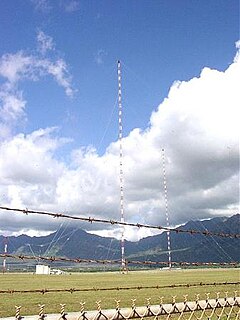
VLF transmitter Lualualei is a facility of the United States Navy near Lualualei, Hawaii transmitting orders to submerged submarines in the very low frequency (VLF) range.

The Lisnagarvey transmitting station is a facility for mediumwave broadcasting located in the townland of Magherageery, on the southern edge of Lisburn, Northern Ireland. It is close to Sprucefield shopping centre and about one mile from the middle of Lisburn.
Venets Transmitter is a facility for FM and TV-broadcasting near Venets and Samuil in Shumen Province, Bulgaria. Venets Transmitter uses as antenna tower a 302 metre tall guyed lattice steel mast with rectangular cross section. This mast, which was built in 1975, is the tallest radio mast in Bulgaria. The TV transmitter, which used it as antenna, was the most powerful TV transmitter in Bulgaria with 50 kW. It broadcast the program of BNT 1 on channel 5 and could be received in Romania, Moldova and Ukraine. In 2008 due to interference with foreign FM radio stations the transmitter was shut down and broadcasting of BNT 1 was switched to channel 56 on a new NEC transmitter. The analogue transmitters were shut down on September 30, 2015, when simulcast period ended and Bulgaria switched to DVB-T.

The Kaliakra transmitter was a huge facility for medium wave broadcasting, which was built after 1988 by the former Soviet Union as a relay transmitter for Southeast Europe. After the collapse of communism in 1989, there was no need for the facility and work was stopped. At that time, nine of the planned 10 masts were already completed and work on the final mast had begun. Some masts were already equipped with cage antennas, while others remained bare.















